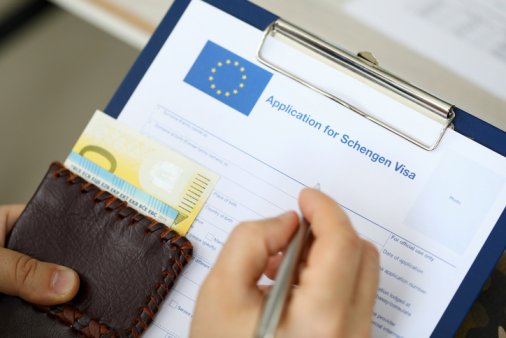Understanding the Schengen Visa Sticker Number: What It Is and Why It Matters
Learn about the Schengen visa sticker number, a unique alphanumeric code that proves your visa's authenticity and plays a crucial role in border control, visa extensions, and travel insurance. Find out how to locate it and what to do if errors occur.
Schengen Visa Sticker Number Explained
-
The Schengen visa sticker number is an alphanumeric code that proves visa authenticity and is required for immigration control in the Schengen Area.
-
The first two letters of the sequence usually represent the country that issued the visa.
-
You can find the visa sticker number at the top right corner of the visa sticker.
The Schengen Visa is your ticket to travel across several European countries at once. But within your visa, the Schengen Visa sticker, often overlooked by travelers, contains important codes and numbers that play a key role in regulating your travel. Among these, the Schengen visa sticker number is a unique identifier, necessary for travel insurance , visa extensions, and administrative processes.
So, let’s go through what this visa sticker number is, how it affects your travel plans and what to do if issues arise.
Key Components of a Schengen Visa Sticker
When you are issued a Schengen visa, the visa sticker is affixed to one of the pages in your passport. This sticker contains various details about your visa, such as your personal information, the type of visa granted, the duration of stay, and the countries you are allowed to visit within the Schengen Area. Among these details, the Schengen Visa Sticker Number stands out as one of the most important elements.
Each Schengen Visa sticker follows a standardized format and contains various codes and details that travelers need to understand. The information provided on this sticker helps border authorities verify your eligibility to enter and stay within the Schengen Area according to the conditions of your visa. In short, the visa sticker is not just a permit but a detailed document ensuring that your travel is lawful and well-regulated.
Structure of the Schengen Visa Sticker
The Schengen Visa sticker might look like a complex document at first glance, but understanding it is crucial for Schengen travelers. Let's break down the key components of the sticker:
First thing you will see on the Schengen Visa sticker is the Visa Type. This indicates if you have been issued a short term or long term visa, marked as "C" or "D". A "C" visa is the most common and allows you to stay in the Schengen Area for up to 90 days within a 180-day period for tourism, business or family visit. A "D" visa is for long term stay, for work or study.
Another important detail is the Number of Entries allowed under your visa. This will be marked as "MULT", "1" or "2". "MULT" means you can enter and exit the Schengen Area multiple times during the validity of the visa, "1" or "2" means you are allowed single or double entry respectively.
The Issuing State field shows which Schengen country issued your visa. This is important because although a Schengen Visa allows you to travel to all Schengen countries, you should typically enter the Schengen Area through the country that issued the visa. In some cases, there might be specific restrictions noted. For example, if the sticker says <<ETATS SCHENGEN(-LVA)>> it means you are allowed to enter all Schengen countries except Latvia. If it says '-SK,' '-HU,' or '-PL' it means you are not allowed to enter Slovakia, Hungary or Poland respectively.
The Valid From/To dates show the period when you can use your visa. The "VALID FROM" date is the earliest you can enter the Schengen Area, and the "VALID TO" date is the last day you can stay. Make sure to respect these dates as overstaying can lead to fines, deportation or even future visa ban.
Related to the validity dates is the Duration of Stay. This is the total number of days you are allowed to stay in the Schengen Area. It's important to note that the overall validity of the visa and the duration of stay are not the same. For example, your visa is valid for 6 months, but you are only allowed to stay 90 days within that period.
Each Schengen Visa sticker has a unique Visa Number, an important identifier that you may need for administrative purposes such as applying for Schengen travel insurance or registering with local authorities. This number is a combination of digits and letters, and you should keep a record of it.
The Place of Issue is another important field which shows where your visa was processed and issued. Usually this is the consulate or embassy of the Schengen country you applied to. In case of any issues or problems during your travel the place of issue can be a useful point of reference.
And finally, the Remarks section on the visa sticker can have additional notes about your stay. These remarks usually provide information about the conditions attached to your visa, such as "business", "tourism" or other reasons like "student" visa.
What is the Schengen Visa Sticker Number?
The Schengen Visa Sticker Number is a unique alphanumeric code printed on every Schengen visa. It’s a reference number that helps authorities (border control officers and immigration officials) to track and verify the visa. The sticker number is for administrative purposes, to link the visa holder to the application, check travel records and monitor the visa conditions.
This number is different from the visa application number or the visa approval number you get during the application process. It’s also a permanent number linked to the visa sticker in your passport. If you get a new Schengen visa in the future, the sticker number will change.
Where to Find the Schengen Visa Sticker Number on the Visa Sticker
To find the Schengen Visa Sticker Number, look at the visa sticker itself, which is typically placed on a full blank page of your passport. The number is usually positioned in the upper right-hand corner of the sticker. It is a combination of letters and digits, and it is printed in a slightly larger font compared to other details on the visa, making it easy to identify.
It may not be explicitly labeled but is distinguishable from other information due to its placement and format. But generally, it's an alphanumeric sequence of 9 to 11 characters. You must separately note down your visa number, along with the issuing country and the date of issue. The visa sticker layout is designed to be clear so you can see all the important info at a glance.
Format of the Sticker Number for Schengen Visa
The Schengen visa sticker number carries coded information, including country code, serial number, and other data. The visa sticker number could either be only numeric, or alphanumeric depending on the type of visa you have.
The first two letters of the sequence usually denote the country that issued the Schengen visa. For example, “FR” is France, “IT” is Italy, and “EST” is Estonia. However, if you have a Uniform Schengen Visa, with access to all the member countries
Here is the list to check the code of the Schengen countries, which you may find on your visa sticker number.
|
Code |
Country |
Code |
Country |
|
AT |
Austria |
IT |
Italy |
|
BE |
Belgium |
IS |
Iceland |
|
BG |
Bulgaria |
LU |
Luxembourg |
|
HR |
Croatia |
LT |
Lithuania |
|
CH |
Switzerland |
LVA |
Latvia |
|
CZE |
Czech Republic |
MT |
Malta |
|
DE |
Germany |
NO |
Norway |
|
DK |
Denmark |
NL |
Netherlands |
|
ES |
Spain |
PT |
Portugal |
|
EST |
Estonia |
PL |
Poland |
|
FR |
France |
RO |
Romania |
|
FIN |
Finland |
SE |
Sweden |
|
GR |
Greece |
SK |
Slovakia |
|
HU |
Hungary |
SVN |
Slovenia |
How the Schengen Visa Sticker Number is Used
The Sticker Number on your Schengen Visa is used to identify, track and verify the visa throughout its validity period. But there’s more to it.
Visa Identification and Tracking
The main purpose of the Schengen Visa Sticker Number is to be an identifier of your visa. Each visa issued to travelers entering the Schengen Area has this number, so immigration authorities, embassies and consulates can track when you enter and exit the Schengen Area and ensure you comply with visa rules like duration of stay and number of entries.
Since the number links the visa to the original application and has a record of all Schengen visas issued to the holder. When applying for future visas, authorities can check your visa history. The visa sticker number also helps to communicate between immigration agencies, consulates and border control. When you contact authorities about your visa, the sticker number is often the reference point to verify your identity and visa details.
Importance for Border Control
The sticker number allows border officers to quickly identify travelers and their visa conditions (number of entries allowed, duration of stay, etc.) without needing to review extensive paperwork.
Also, by checking the visa sticker number against records of previous border crossings, officers can ensure that travelers are not overstaying their permitted duration or entering more times than allowed by their visa type.
How to Correct Mistakes on a Schengen Visa Sticker
One common problem travelers face is the damaged sticker number. This can happen because of damage to the passport or the sticker itself. In this case, travelers should contact the issuing embassy or consulate as soon as possible to request a new visa or clarification on the issue.
Another problem that travelers might face is with the visa sticker, where the information doesn’t match the data in the immigration system. This can be due to a clerical error or a problem with the visa application process. In this case, travelers must get the errors fixed immediately. Contact the embassy that issued your visa for mistakes, such as the wrong passport number, personal details, or travel dates.
Give them your passport details and any supporting documents for your case. When you contact them, clearly explain the error and ask for correction or re-issuance of the visa sticker.
FAQs
1. What if the sticker number is faded or unclear?
Contact the consulate or embassy that issued the visa immediately. They may issue a new sticker or provide guidance on getting a new visa.
2. How does the sticker number relate to other visa information?
The Schengen visa sticker number is different from other numbers like application IDs or national IDs, which serve different purposes in visa processing and immigration records.
3. Why is the sticker number important for appeals or complaints?
The sticker number is required for any appeals or complaints about visa validity. Referencing it helps immigration authorities to verify your visa details and resolve issues faster.

Travel Assistance Wherever, Whenever
Speak with one of our licensed representatives or our 24/7 multilingual insurance advisors to find the coverage you need for your next trip. Contact Here
Related Articles
Schengen for Greencard Holders




